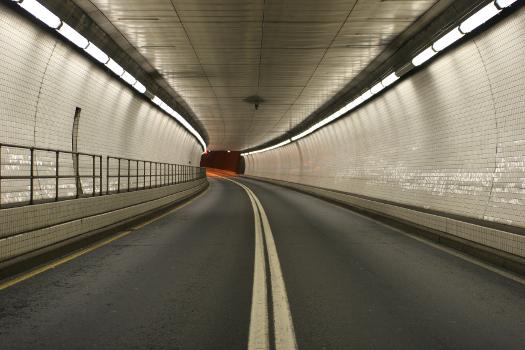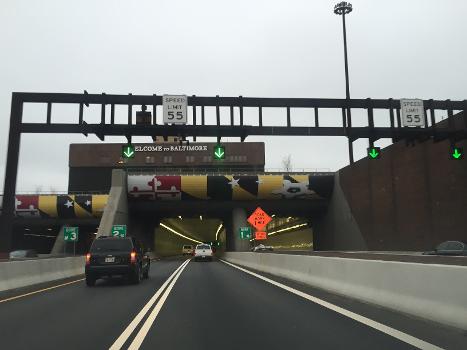General Information
Project Type
| Structure: |
Immersed tube tunnel |
|---|---|
| Function / usage: |
Road tunnel |
| Construction method: |
Immersed tube method |
Awards and Distinctions
| 1986 |
Award of Merit
for registered users |
|---|
Location
| Location: |
Baltimore, Maryland, USA |
|---|---|
| For: |
|
| Part of: | |
| Coordinates: | 39° 15' 51.51" N 76° 35' 23.55" W |
| Coordinates: | 39° 15' 50.08" N 76° 33' 58.50" W |
Technical Information
Dimensions
| tunnel length | 2.4 km |
Cost
| cost of construction | United States dollar 750 000 000 |
Materials
| tunnel structure |
reinforced concrete
|
|---|
Chronology
| 24 November 1985 | Opening. |
|---|
Excerpt from Wikipedia
The Fort McHenry Tunnel is a four-tube, bi-directional tunnel that carries traffic on Interstate 95 (I-95) underneath the Baltimore Harbor. The lowest point in the Interstate System under water, the tunnel is named for nearby Fort McHenry.
The tunnel was constructed from May 1980 to November 1985, at a cost of about $750 million. At the time of ist opening on November 23, 1985, it was the most expensive underwater tunnel project in the United States, but that figure has since been surpassed by the Big Dig project in Boston.
The tunnel's annual traffic in 2009 was 43.4 million vehicles. As of July 1, 2015[update], the toll rate for cars is $4.00 cash or $3.00 E-Zpass, paid in both directions. Vehicles with more than two axles pay additional amounts, up to $30.00 for six axles. In March 2020, all-electronic tolling was implemented as a result of the COVID-19 pandemic, with tolls payable through E-Zpass or Video Tolling, which uses automatic license plate recognition. All-electronic tolling was made permanent in August 2020.
Location
The tunnel crosses the Patapsco River, just south of Fort McHenry and connects the Locust Point and Canton areas of Baltimore City.
Design and construction
Plans for a second crossing of the Baltimore Harbor that would become the Fort McHenry Tunnel began in the late 1960s. Early plans called for an 8-lane double-deck bridge to carry I-95 over the harbor just south of Fort McHenry. In 1975, plans were changed from a bridge to a tunnel when it was determined that a bridge would have detrimental impact on Fort McHenry's status as a national monument. The state of Maryland originally intended to build the tunnel with a reinforced concrete box design, but plans were changed in February 1976 to use a steel tubular design after a dispute with the Federal Highway Administration. The tunnel was to be constructed using the immersed tube method, with prefabricated tubes sunken into the harbor.
Construction began in May 1980 by K-R-T (a joint venture between Peter Kiewit Sons Company, Raymond International Builders, and Tidewater Construction Corporation), and was completed in November 1985. 90 percent of construction costs were covered by federal funding, while 10 percent came from state funding. The tunnel consists of 32 tube sections, each 82 feet (25 m) wide and 42 feet (13 m) tall. The east and west approaches are 1,600 feet (490 m) and 3,200 feet (980 m) long, respectively.
The opening of the tunnel closed a gap that previously existed in I-95 through Maryland. The Fort McHenry Tunnel was opened on time and under ist budget, and it continues to be a vital transportation link in the Mid-Atlantic region. Soon after the Fort McHenry Tunnel opened, the nearby Baltimore Harbor Tunnel, which had opened to traffic in 1957, was extensively rehabilitated.
Text imported from Wikipedia article "Fort McHenry Tunnel" and modified on 29 December 2021 according to the CC-BY-SA 3.0 license.
Participants
Relevant Web Sites
- About this
data sheet - Structure-ID
20002477 - Published on:
04/12/2001 - Last updated on:
29/12/2021


_in_Baltimore_City,_Maryland.jpg)





